Threshold Voltage Adjustment by Varying Ge Content in SiGe p-Channel for Single Metal Shared Gate Complementary FET (CFET)
Abstract
:1. Introduction
2. Device Structure and Simulation Methodology
- The drift-diffusion model was included with the coupled Possion’s and continuity equations to determine the electrostatic potential and carrier transport.
- The density gradient model was included to correct the quantum confinement effect in the drift-diffusion model due to the highly scaled dimension [20].
- The doping-concentration-dependent Shockley–Read–Hall (SRH) recombination model was included for the generation–recombination mechanism.
- The Slotboom bandgap narrowing model was included for doping-concentration-dependent bandgap correction [21].
- The doping-dependent, transverse field dependence, and high-field saturation mobility models were included to consider impurity scattering, interfacial surface roughness scattering, and coulomb scattering degradations.
- A ballistic mobility model was considered for quasi-ballistic transport.
3. Results and Discussion
4. Conclusions
Author Contributions
Funding
Institutional Review Board Statement
Informed Consent Statement
Data Availability Statement
Acknowledgments
Conflicts of Interest
References
- Huang, C.-Y.; Dewey, G.; Mannebach, E.; Phan, A.; Morrow, P.; Rachmady, W.; Tung, I.-C.; Thomas, N.; Alaan, U.; Paul, R.; et al. 3-D Self-aligned Stacked NMOS-on-PMOS Nanoribbon Transistors for Continued Moore’s Law Scaling. In Proceedings of the 2020 IEEE International Electron Devices Meeting (IEDM), San Francisco, CA, USA, 12–18 December 2020; pp. 1–4. [Google Scholar] [CrossRef]
- Ryckaert, J.; Schuddinck, P.; Weckx, P.; Bouche, G.; Vincent, B.; Smith, J.; Sherazi, Y.; Mallik, A.; Mertens, H.; Demuynck, S.; et al. The Complementary FET (CFET) for CMOS scaling beyond N3. In Proceedings of the 2018 IEEE Symposium on VLSI Technology, Honolulu, HI, USA, 18–22 June 2018; pp. 141–142. [Google Scholar] [CrossRef]
- Subramanian, S.; Hosseini, M.; Chiarella, T.; Sarkar, S.; Schuddinck, P.; Chan, B.T.; Radisic, D.; Mannaert, G.; Hikavyy, A.; Rosseel, E.; et al. First Monolithic Integration of 3D Complementary FET (CFET) on 300mm Wafers. In Proceedings of the 2020 IEEE Symposium on VLSI Technology, Honolulu, HI, USA, 16–19 June 2020; pp. 1–2. [Google Scholar] [CrossRef]
- Rachmady, W.; Agrawal, A.; Sung, S.H.; Dewey, G.; Chouksey, S.; Chu-Kung, B.; Elbaz, G.; Fischer, P.; Huang, C.Y.; Jun, K.; et al. 300 mm Heterogeneous 3D Integration of Record Performance Layer Transfer Germanium PMOS with Silicon NMOS for Low Power High Performance Logic Applications. In Proceedings of the 2019 IEEE International Electron Devices Meeting (IEDM), San Francisco, CA, USA, 7–11 December 2019; pp. 1–4. [Google Scholar]
- Ragnarsson, L.Å.; Chew, S.A.; Dekkers, H.; Luque, M.T.; Parvais, B.; De Keersgieter, A.; Devriendt, K.; Van Ammel, A.; Schram, T.; Yoshida, N.; et al. Highly scalable bulk FinFET Devices with Multi-VT options by conductive metal gate stack tuning for the 10-nm node and beyond. In Proceedings of the 2014 Symposium on VLSI Technology (VLSI-Technology): Digest of Technical Papers, Honolulu, HI, USA, 9–12 June 2014; pp. 1–2. [Google Scholar] [CrossRef]
- Ragnarsson, L.-A.; Dekkers, H.; Matagne, P.; Schram, T.; Conard, T.; Horiguchi, N.; Thean, A.V.-Y. Zero-thickness multi work function solutions for N7 bulk FinFETs. In Proceedings of the 2016 IEEE Symposium on VLSI Technology, Honolulu, HI, USA, 14–16 June 2016; pp. 1–2. [Google Scholar] [CrossRef]
- Yoshida, N.; Hassan, S.; Tang, W.; Yang, Y.; Zhang, W.; Chen, S.C.; Dong, L.; Zhou, H.; Jin, M.; Okazaki, M.; et al. Highly conductive metal gate fill integration solution for extremely scaled RMG stack for 5 nm & beyond. In Proceedings of the 2017 IEEE International Electron Devices Meeting (IEDM), San Francisco, CA, USA, 2–6 December 2017; pp. 1–4. [Google Scholar] [CrossRef]
- Ritzenthaler, R.; Mertens, H.; Pena, V.; Santoro, G.; Chasin, A.; Kenis, K.; Devriendt, K.; Mannaert, G.; Dekkers, H.; Dangol, A.; et al. Vertically Stacked Gate-All-Around Si Nanowire CMOS Transistors with Reduced Vertical Nanowires Separation, New Work Function Metal Gate Solutions, and DC/AC Performance Optimization. In Proceedings of the 2018 IEEE International Electron Devices Meeting (IEDM), San Francisco, CA, USA, 1–5 December 2018; pp. 1–4. [Google Scholar] [CrossRef]
- Sung, P.-J.; Chang, S.-W.; Kao, K.-H.; Wu, C.-T.; Su, C.-J.; Cho, T.-C.; Hsueh, F.-K.; Lee, W.-H.; Lee, Y.-J.; Chao, T.-S. Fabrication of Vertically Stacked Nanosheet Junctionless Field-Effect Transistors and Applications for the CMOS and CFET Inverters. IEEE Trans. Electron. Devices 2020, 67, 3504–3509. [Google Scholar] [CrossRef]
- Bao, R.; Watanabe, K.; Zhang, J.; Zhou, H.; Sankarapandian, M.; Li, J.; Pancharatnam, S.; Jamison, P.; Southwick, R.G.; Wang, M.; et al. Selective Enablement of Dual Dipoles for near Bandedge Multi-Vt Solution in High Performance FinFET and Nanosheet Technologies. In Proceedings of the 2020 IEEE Symposium on VLSI Technology, Honolulu, HI, USA, 16–19 June 2020; pp. 1–2. [Google Scholar] [CrossRef]
- Xu, R.; Yao, J.; Xu, G.; Wei, Y.; Yin, H.; Zhang, Q.; Tian, G.; Wang, Y.; Yan, G.; Xiang, J.; et al. Experimental Investigation of Ultrathin Al2O3 Ex-Situ Interfacial Doping Strategy on Laminated HKMG Stacks via ALD. IEEE Trans. Electron. Devices 2022, 69, 1964–1971. [Google Scholar] [CrossRef]
- Kumar, P.; Leroux, C.; Mohamad, B.; Toffoli, A.; Romano, G.; Garros, X.; Reimbold, G.; Domengie, F.; Segovia, C.S.; Ghibaudo, G. Effect of La and Al addition used for threshold voltage shift on the BTI reliability of HfON-based FDSOI MOSFETs. In Proceedings of the 2017 IEEE International Reliability Physics Symposium (IRPS), Monterey, CA, USA, 2–6 April 2017; pp. 1–7. [Google Scholar] [CrossRef]
- Arimura, H.; Ragnarsson, L.-A.; Oniki, Y.; Franco, J.; Vandooren, A.; Brus, S.; Leonhardt, A.; Sippola, P.; Ivanova, T.; Verni, G.A.; et al. Dipole-First Gate Stack as a Scalable and Thermal Budget Flexible Multi-Vt Solution for Nanosheet/CFET Devices. In Proceedings of the 2021 IEEE International Electron Devices Meeting (IEDM), San Francisco, CA, USA, 11–16 December 2021; pp. 1–4. [Google Scholar] [CrossRef]
- Thompson, S.; Armstrong, M.; Auth, C.; Alavi, M.; Buehler, M.; Chau, R.; Cea, S.; Ghani, T.; Glass, G.; Hoffman, T.; et al. A 90-nm Logic Technology Featuring Strained-Silicon. IEEE Trans. Electron. Devices 2004, 51, 1790–1797. [Google Scholar] [CrossRef]
- Harris, H.R.; Kalra, P.; Majhi, P.; Hussain, M.; Kelly, D.; Oh, J.; He, D.; Smith, C.; Barnett, J.; Kirsch, P.D.; et al. Band-Engineered Low PMOS VT with High-K/Metal Gates Featured in a Dual Channel CMOS Integration Scheme. In Proceedings of the 2007 IEEE Symposium on VLSI Technology, Kyoto, Japan, 12–14 June 2007; pp. 154–155. [Google Scholar] [CrossRef]
- Guo, D.; Karve, G.; Tsutsui, G.; Lim, K.-Y.; Robison, R.; Hook, T.; Vega, R.; Liu, D.; Bedell, S.; Mochizuki, S.; et al. FINFET technology featuring high mobility SiGe channel for 10nm and beyond. In Proceedings of the 2016 IEEE Symposium on VLSI Technology, Honolulu, HI, USA, 14–16 June 2016; pp. 1–2. [Google Scholar] [CrossRef]
- Lee, C.H.; Mochizuki, S.; Southwick, R.G.; Li, J.; Miao, X.; Bao, R.; Ando, T.; Galatage, R.; Siddiqui, S.; Labelle, C.; et al. A comparative study of strain and Ge content in Si1−xGex channel using planar FETs, FinFETs, and strained relaxed buffer layer FinFETs. In Proceedings of the 2017 IEEE International Electron Devices Meeting (IEDM), San Francisco, CA, USA, 2–6 December 2017; pp. 1–4. [Google Scholar] [CrossRef]
- Sentaurus TCAD, version 2016; Synopsys: Mountain View, CA, USA, 2016.
- International Roadmap for Devices and Systems (IRDS™), IRDS. 2020. Available online: https://irds.ieee.org/editions/2020 (accessed on 23 July 2020).
- Ancona, M.G.; Tiersten, H.F. Macroscopic physics of the silicon inversion layer. Phys. Rev. B 1987, 35, 7959–7965. [Google Scholar] [CrossRef] [PubMed]
- Slotboom, J.; de Graaff, H. Measurements of bandgap narrowing in Si bipolar transistors. Solid State Electron. 1976, 19, 857–862. [Google Scholar] [CrossRef]
- Levinshtein, M.E.; Rumyantsev, S.L.; Michael, S.S. Properties of Advanced Semiconductor Materials GaN, AlN, SiC, BN, SiC, SiGe; John Wiley & Sons, Inc.: New York, NY, USA, 2001; pp. 149–185. [Google Scholar]
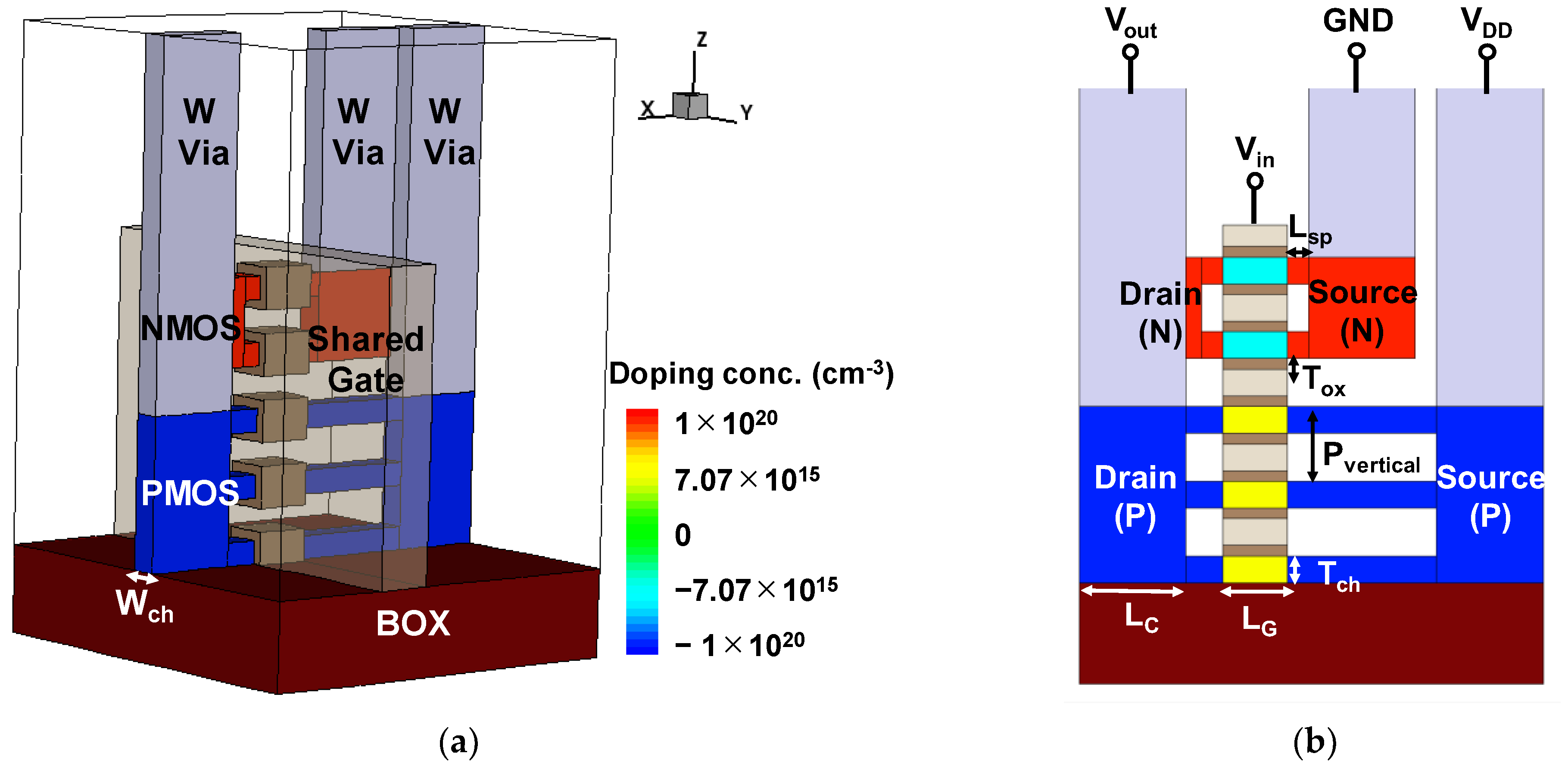
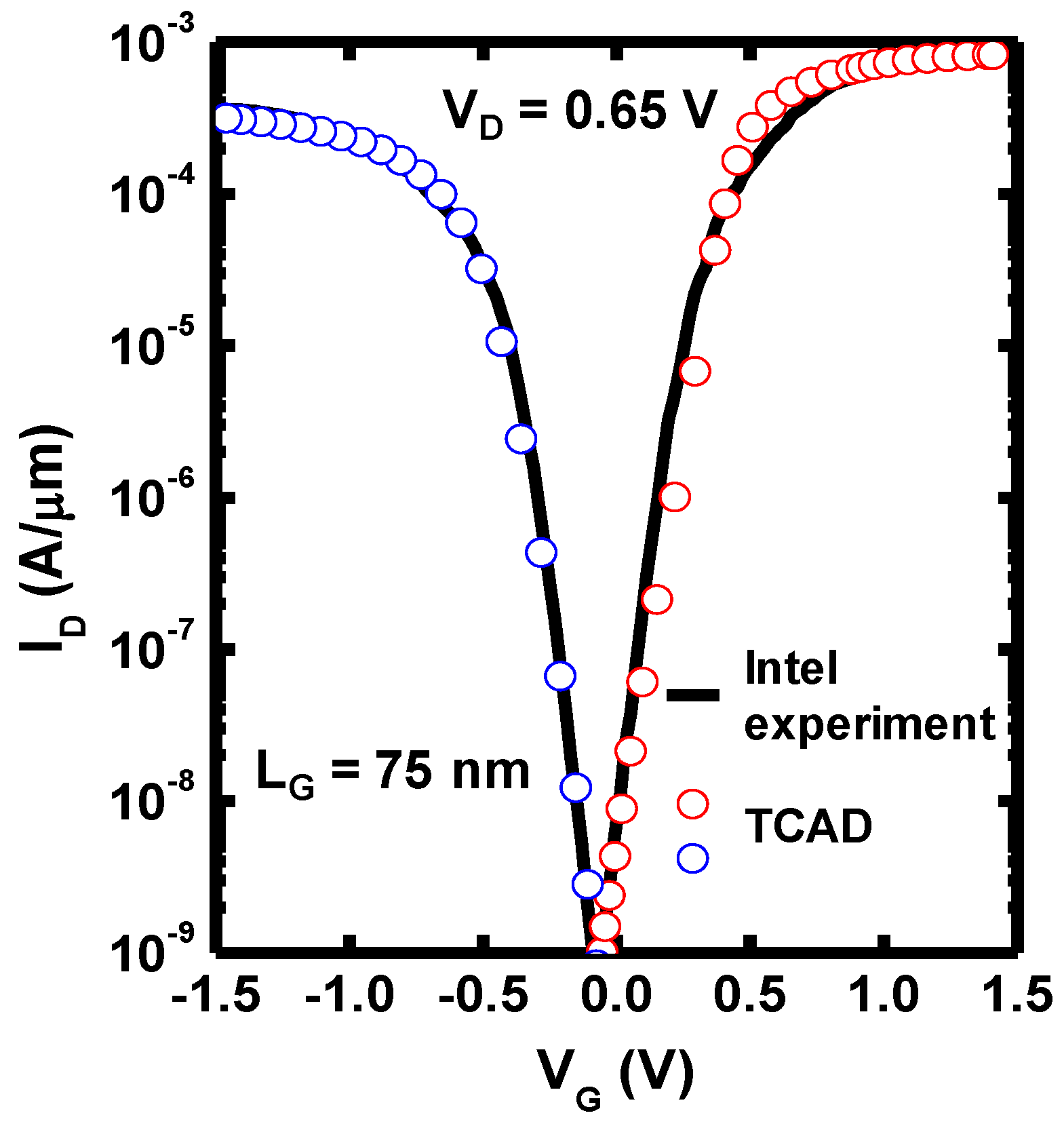
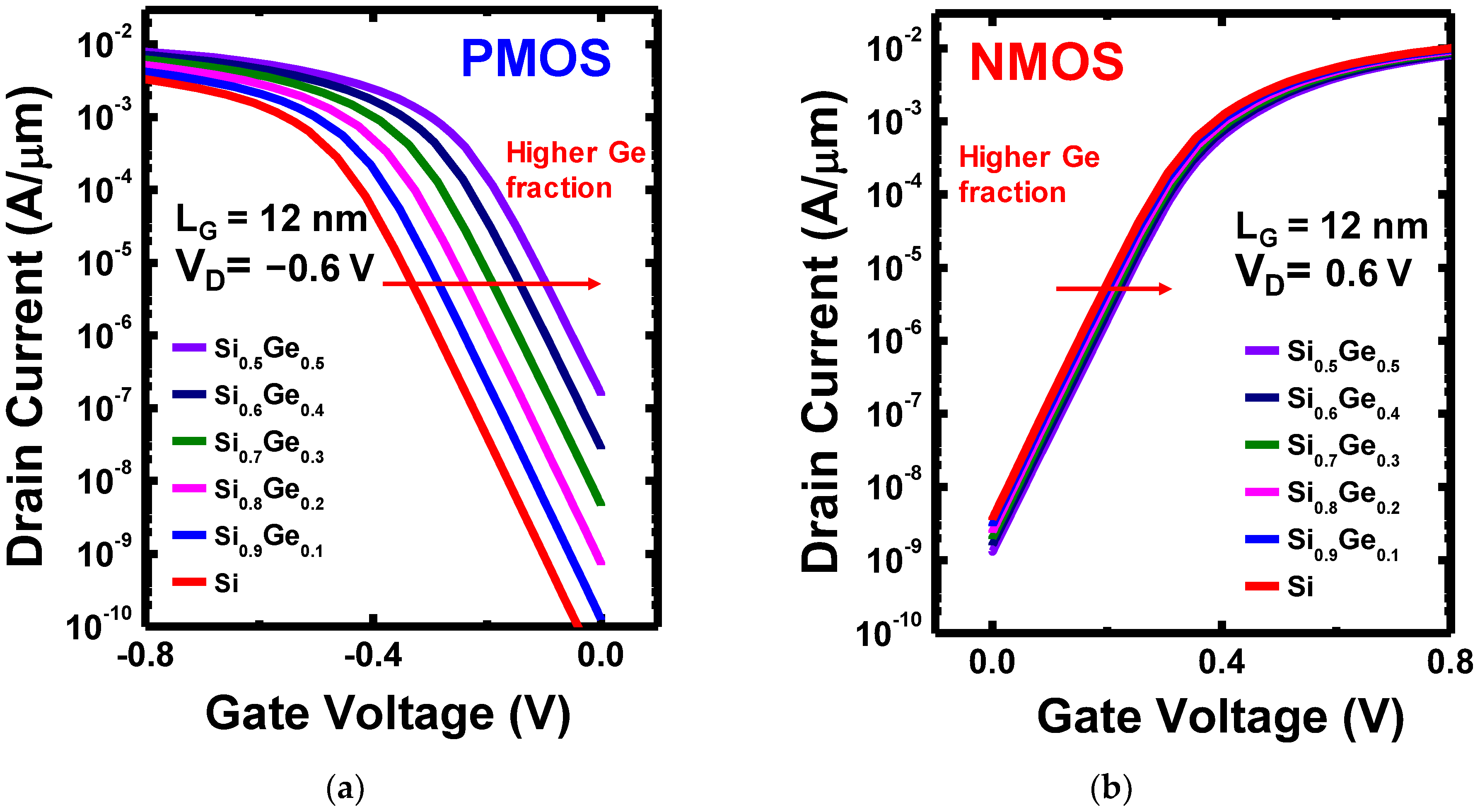
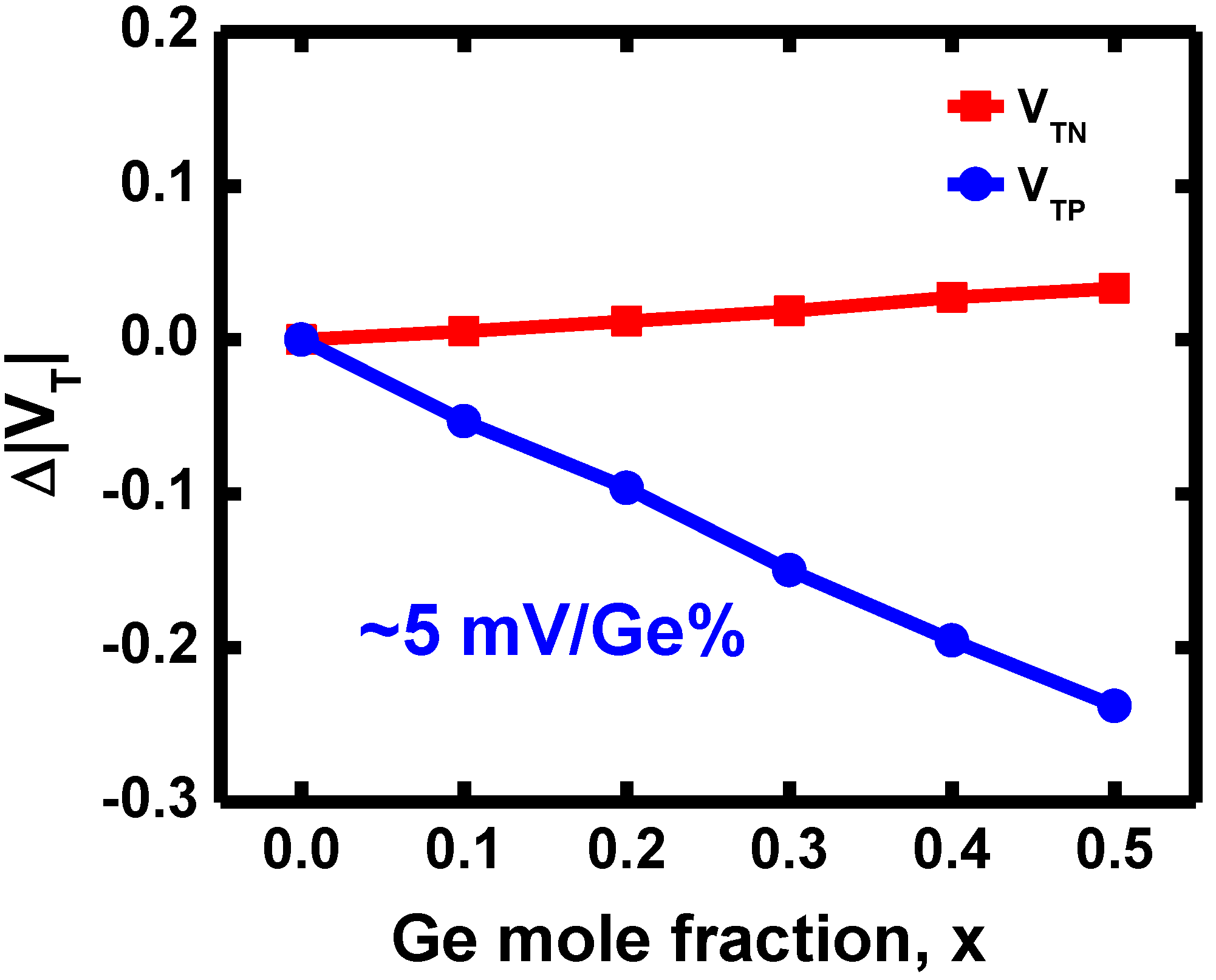
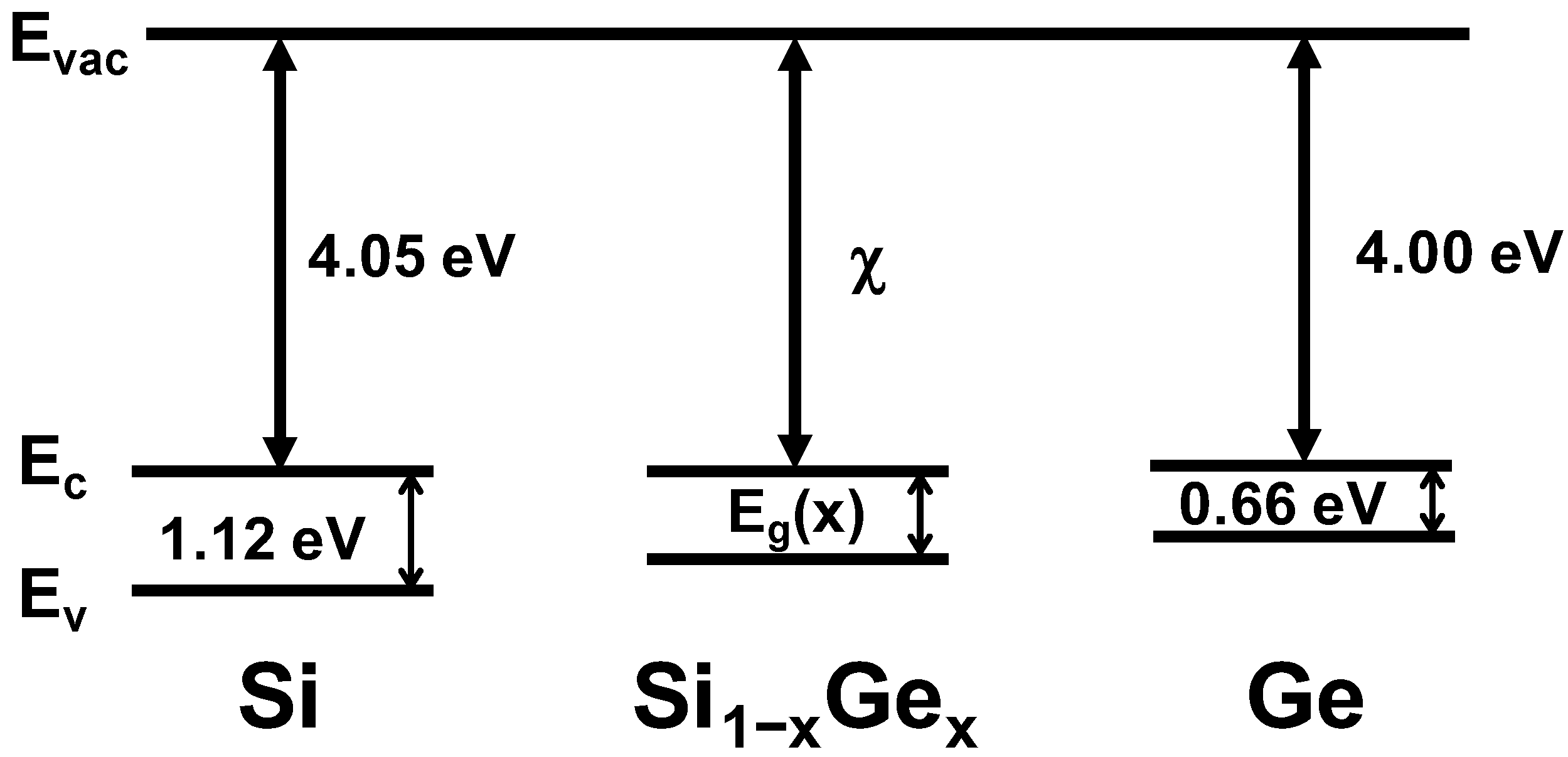


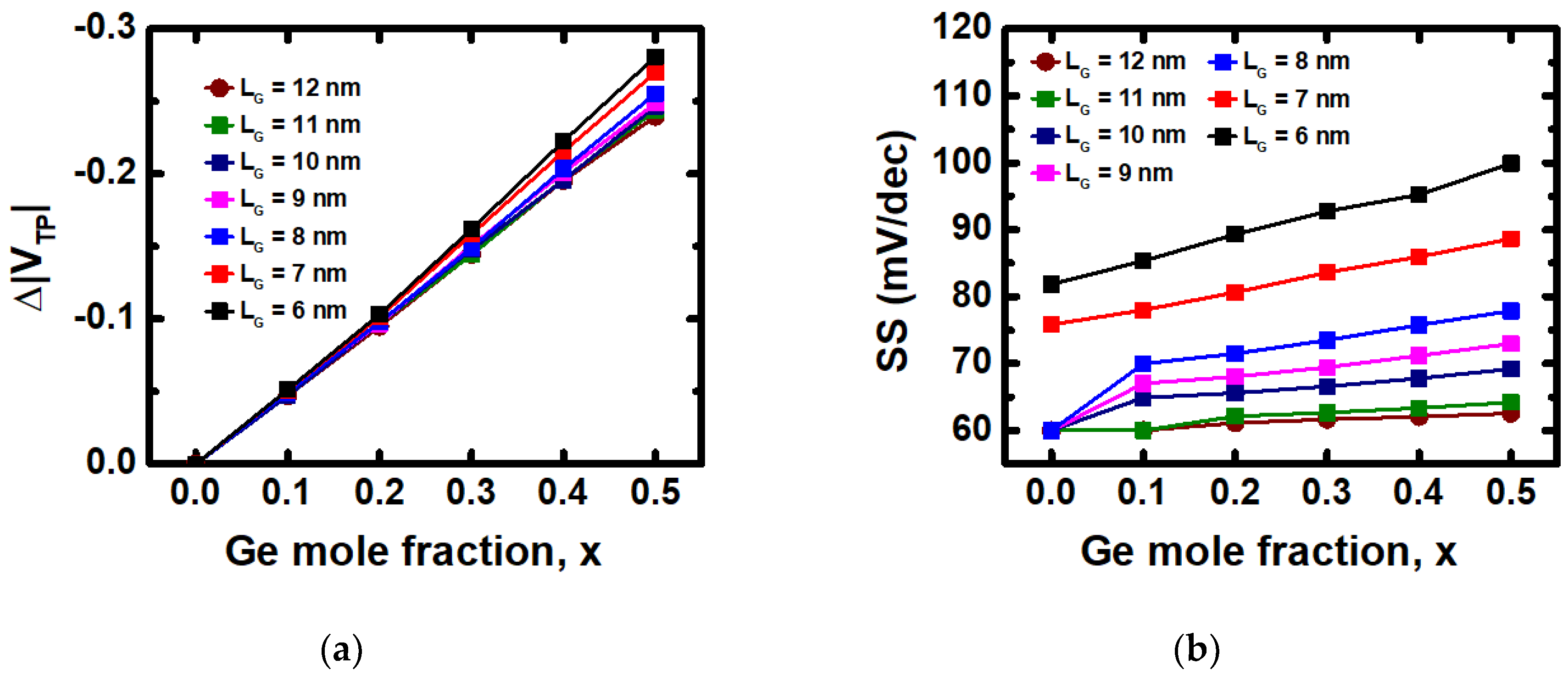
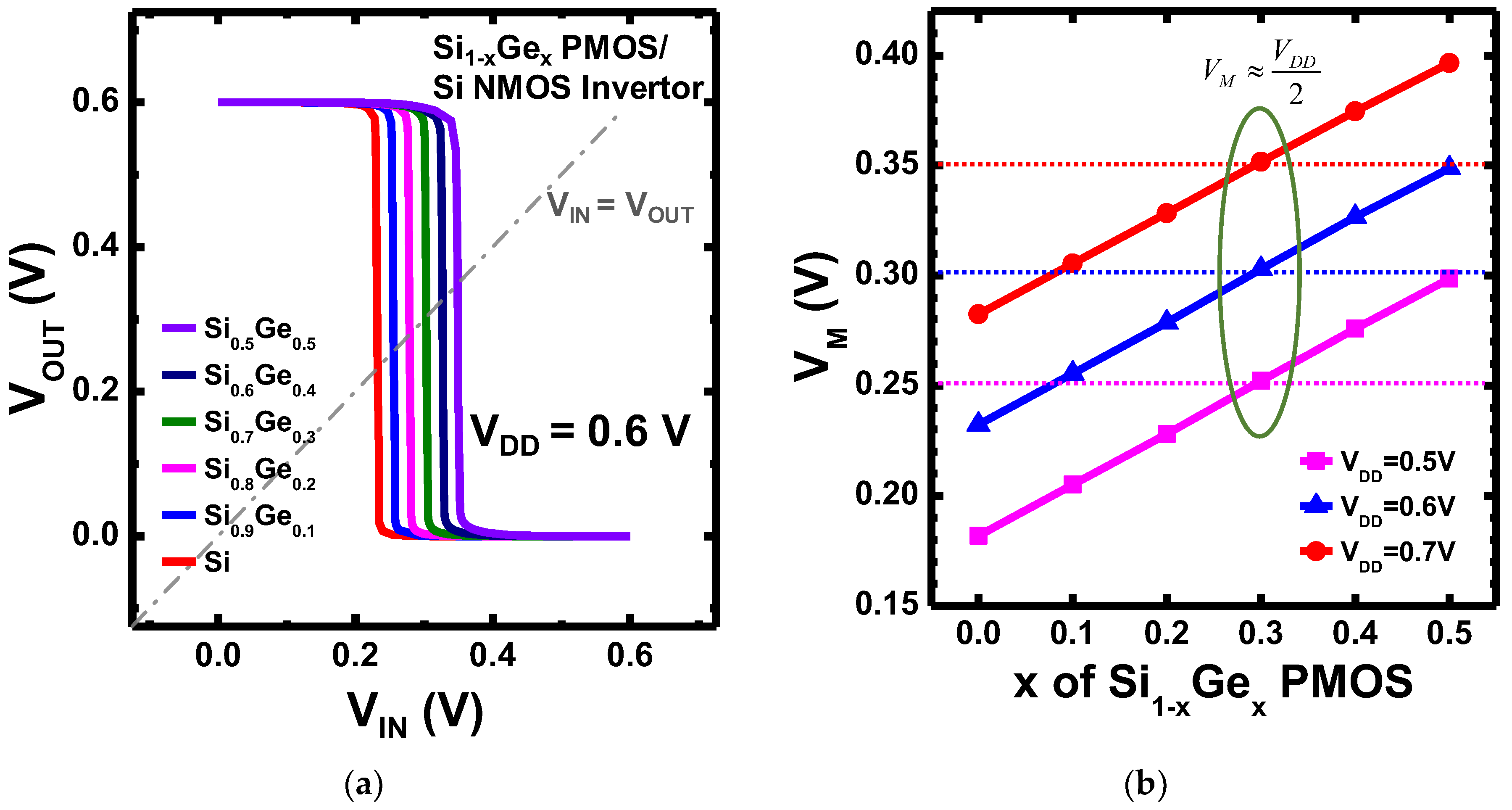
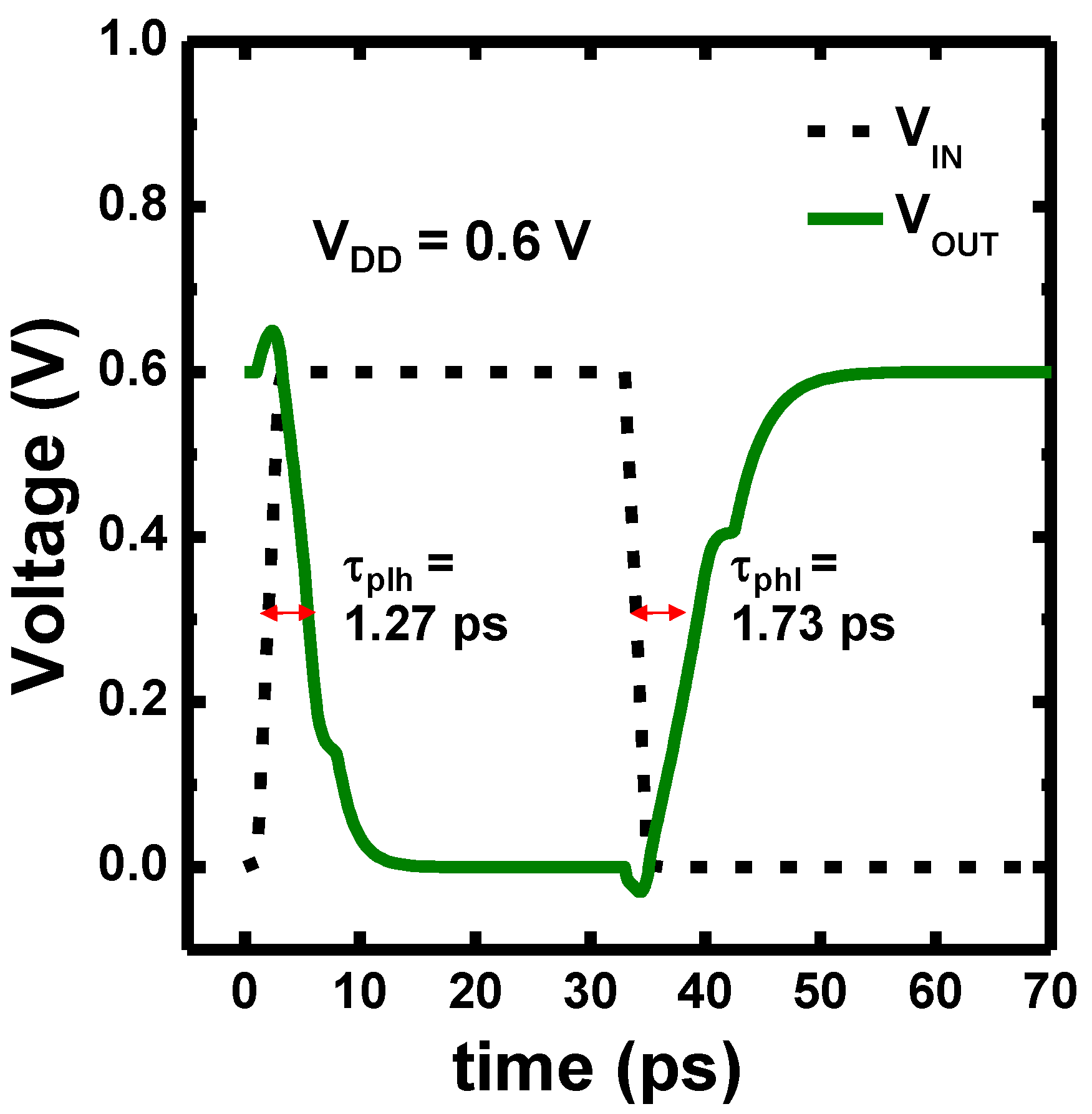
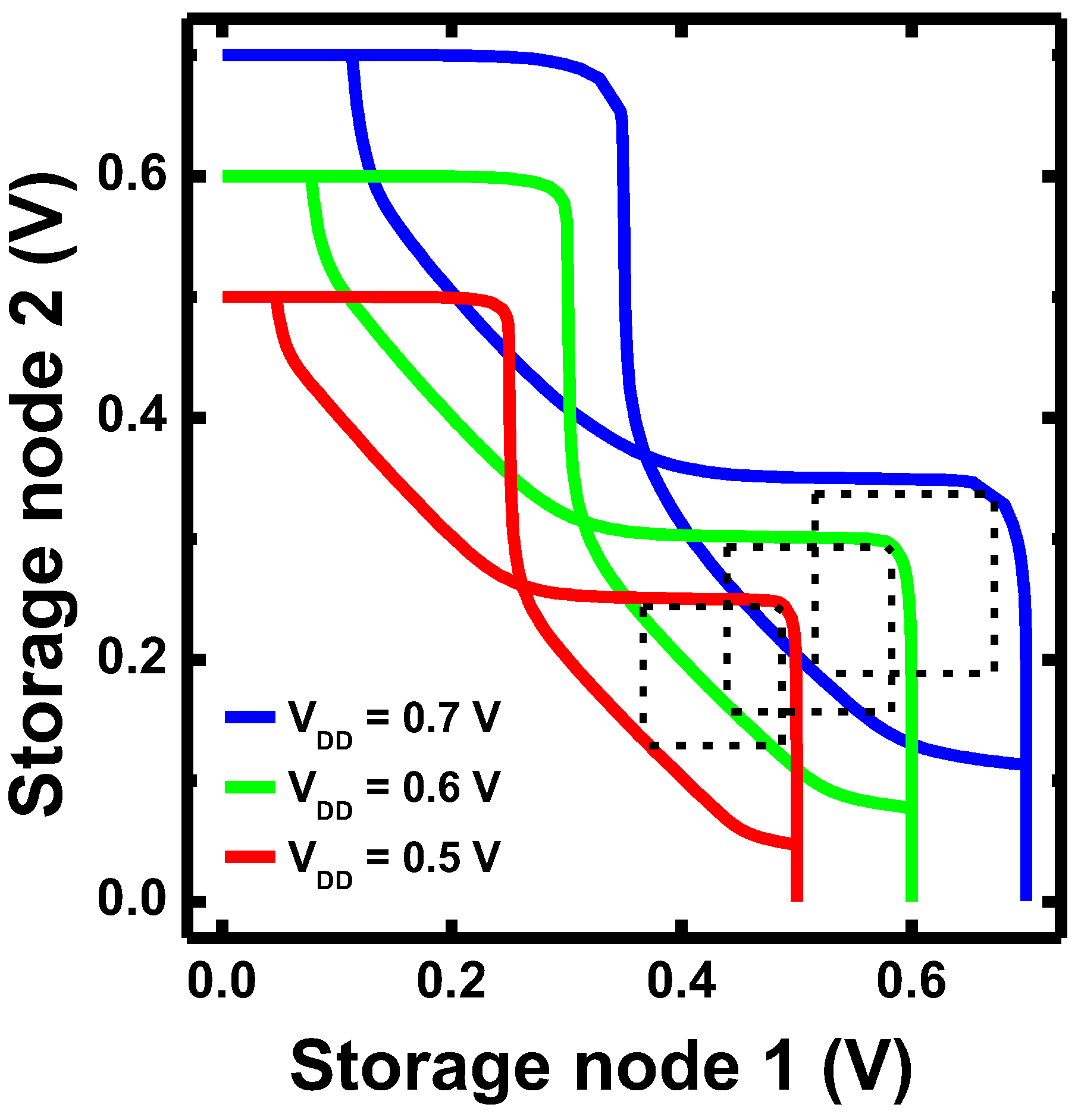
| Fixed Parameter | Quantity | Value |
|---|---|---|
| Wch | Channel width | 6 nm |
| Tch | Channel thickness | 5 nm |
| Tox | Gate oxide thickness (HfO2) | 2 nm |
| Pvertical | Channel vertical pitch | 14 nm |
| Lsp | Spacer length | 4 nm |
| LC | S/D contact length | 20 nm |
| NS/D | S/D Doping concentration | 1 × 1020 cm−3 |
| Nch | Channel Doping concentration | 1 × 1016 cm−3 |
| Variable Parameter | Quantity | Value |
| x | Ge mole fraction of Si1-xGex channel | 0–0.5 |
| LG | Gate length | 6-12 nm |
Publisher’s Note: MDPI stays neutral with regard to jurisdictional claims in published maps and institutional affiliations. |
© 2022 by the authors. Licensee MDPI, Basel, Switzerland. This article is an open access article distributed under the terms and conditions of the Creative Commons Attribution (CC BY) license (https://creativecommons.org/licenses/by/4.0/).
Share and Cite
Sun, C.-J.; Wu, C.-H.; Yao, Y.-J.; Lin, S.-W.; Yan, S.-C.; Lin, Y.-W.; Wu, Y.-C. Threshold Voltage Adjustment by Varying Ge Content in SiGe p-Channel for Single Metal Shared Gate Complementary FET (CFET). Nanomaterials 2022, 12, 3712. https://doi.org/10.3390/nano12203712
Sun C-J, Wu C-H, Yao Y-J, Lin S-W, Yan S-C, Lin Y-W, Wu Y-C. Threshold Voltage Adjustment by Varying Ge Content in SiGe p-Channel for Single Metal Shared Gate Complementary FET (CFET). Nanomaterials. 2022; 12(20):3712. https://doi.org/10.3390/nano12203712
Chicago/Turabian StyleSun, Chong-Jhe, Chen-Han Wu, Yi-Ju Yao, Shan-Wen Lin, Siao-Cheng Yan, Yi-Wen Lin, and Yung-Chun Wu. 2022. "Threshold Voltage Adjustment by Varying Ge Content in SiGe p-Channel for Single Metal Shared Gate Complementary FET (CFET)" Nanomaterials 12, no. 20: 3712. https://doi.org/10.3390/nano12203712
APA StyleSun, C.-J., Wu, C.-H., Yao, Y.-J., Lin, S.-W., Yan, S.-C., Lin, Y.-W., & Wu, Y.-C. (2022). Threshold Voltage Adjustment by Varying Ge Content in SiGe p-Channel for Single Metal Shared Gate Complementary FET (CFET). Nanomaterials, 12(20), 3712. https://doi.org/10.3390/nano12203712






